The only certainty in spectacle lens design is that the minute you think you’ve got a great selection of lens options, a new slate of products hits the market. The oldest product category in eye care—by a margin of centuries—still manages to continually reinvent itself with new products and refinements to existing ones.
Fashion frames get a lot of attention, and rightfully so, as these are huge drivers of a patient’s buying habits and overall satisfaction with their experience at an eyecare practice or optical shop. But the key reason people come to our establishments is to see better. New ophthalmic lens technologies are changing the product landscape and broadening the options to provide the best possible visual experience in all settings. Here, I will discuss several recent launches and trends that might be worth adding to your lineup. Some are newer than others, but all are unique and noteworthy.
Hoya Vision Care's MySV
A notable new lens is the MySV from Hoya Vision Care. This lens uses aspheric and atoric curves in order to improve the aesthetic of the finished lens edge and enhance the visual experience for the wearer by widening their perceived field of vision, especially when compared to traditional spherical lens designs. It incorporates freeform technology and design compensation to correct oblique, or off-gaze, aberrations that can be found in traditional spherical lens designs. The lens design also considers Listing’s law when calculating and compensating for how the position of wear, as well as the eye’s axis of rotation, will affect the perception of prescription in areas of the lens outside of the optical center. Wearers of these lenses often report a noticeable improvement in the way of visual comfort, increased clarity in their peripheral vision and increased satisfaction with their single vision spectacles overall.
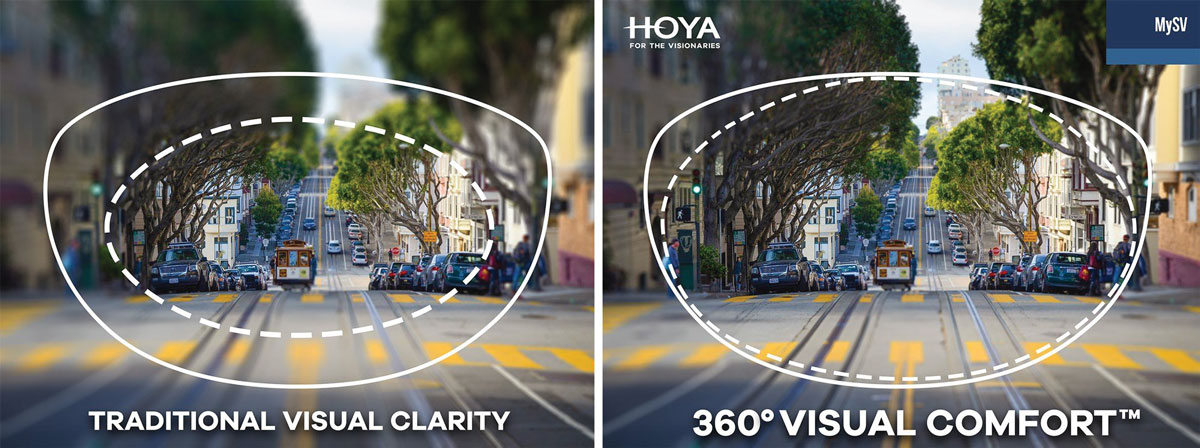 |
Attention to detail of the lens edge designs in the Hoya MySV lens not only reduces thickness in high prescriptions but also improves clarity of the wearer’s peripheral vision. Click image to enlarge. |
IOT's Camber Steady Plus Progressive
This lens from IOT turns convention on its head, as every ounce of the design challenges the status quo. The Camber Steady Plus progressive addition lens (PAL) uses a lens blank that has variable base curves on the front surface to compensate for the need for a steeper curve as the add power increases at the bottom of the lens. Then, when the back side compensations are taken into account, the end result is the feeling of width in both the near zone as well as the distance zone, which can be perceived by the wearer as increased peripheral vision.
This lens also uses something called “Digital Ray-Path 2 technology,” which takes into account the accommodative power of the eye when considering the compensations necessary within the lens design, and an approach called “Steady Plus” that maximizes the intermediate vision zone and creates an easy transition between the midrange and near vision zones. This combination can serve to reduce the peripheral “swim” effect that PAL users often experience. By contrast, wearers of this lens report easier adaptation to PAL wear and are more pleased with the aesthetic of the finished lens, as the variable base curve design yields a flatter, thinner lens than a traditionally designed PAL.
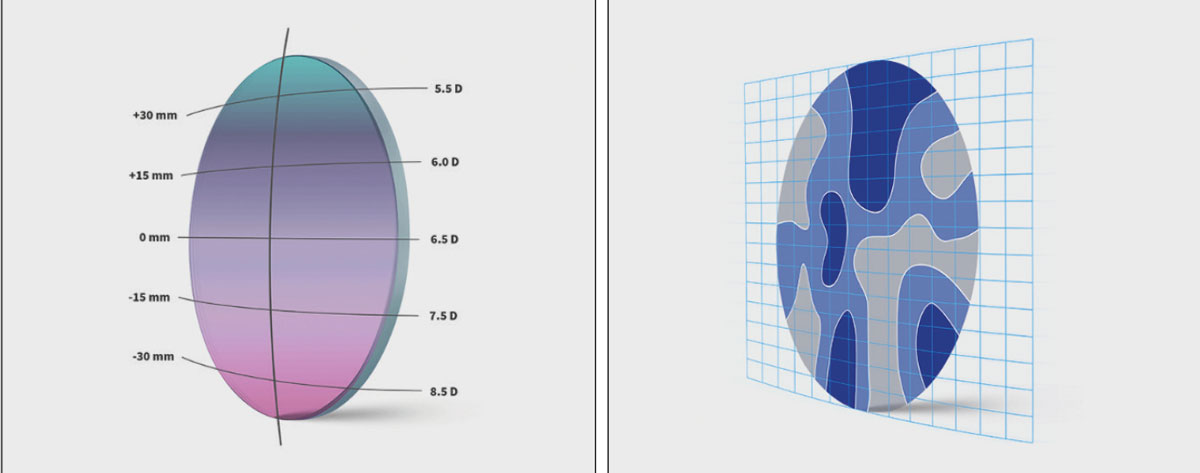 |
Using a variable front surface base curve (left), the IOT Camber lens blank creates a continuously increasing curve that is better suited for progressive prescriptions, the company says. A design approach that compensates for peripheral aberrations (right) and accounts for the wearer’s accommodation reduces aberrations across the field of vision. IOT also says the designs incorporate strict control of mean power to reduce spherical error laterally, resulting in improved lateral vision and superior image stability. Click image to enlarge. |
Zeiss DriveSafe Progressive
This lens from Zeiss meets a need that few others on the market are geared toward: DriveSafe seeks to create solutions for the complex visual tasks and lighting situations that occur while driving, especially at night. Low-lighting conditions allow the driver’s pupil to dilate slightly in mesopic lighting conditions, which would be fine until you consider the quick lighting change that occurs when oncoming bright headlamps cause a quick change to photopic lighting conditions.
The DriveSafe lens is designed to perform especially well in mesopic vision (low-lighting conditions, which result in a wearer with a slightly dilated pupil) to minimize the increased peripheral aberrations that would happen with a traditionally designed PAL. This is recommended to be used in combination with Zeiss’s DuraVision DriveSafe antireflective (AR) coating, which is designed to create more contrast and to decrease glare when encountering new high-intensity discharge and LED headlamps.
The overall design maximizes the distance vision portion of the lens, as the rigorous R&D testing for the development indicated that drivers tend to focus straight ahead and on distant and moving objects about 97% of the time while driving (vs. spending that amount of time in the intermediate or near vision zones). So, maximizing the distance portion of this PAL design makes the wearer less bothered by the unwanted peripheral distortion that typically occurs in more traditionally designed general use progressive lenses.
The DriveSafe lens incorporates a long and soft intermediate corridor in order to keep the width of the distance portion of the design intact. In short, if you’re one who drives often at night and experiences discomfort associated with lighting conditions and complex visual tasks of driving, this lens might be one for you to try.
 |
Patients who have concerns about clarity of vision while driving at night can get a better experience with Zeiss DriveSafe progressives. The design prioritizes distance vision (essential while driving) and minimize the adverse effects of glare from oncoming headlights. Click image to enlarge. |
Essilor's Varilux X Series Progressive
These lens options are designed to neutralize wavefront aberrations, typically in the form of high-order aberrations, which usually present to the wearer in the way of visual distortion within the lenses. Using this compensatory feature in the X Series lenses can leave the patient with a perception of increased clarity within the lens.
The design also takes into account each eye’s refractive correction with modifications to encourage the eyes to work together better and create a set of lenses truly designed for binocularity (Essilor calls this “SynchronEyes technology”). These lenses can be especially effective in patients with asymmetric prescriptions and are designed to create a balanced viewing experience.
However, what really differentiates the Varilux X design is a feature that allows the wearer multiple near viewing distances through one point in the lens (called “Xtend technology” by the company). Wearers often report more forgiveness, as the design allows a dramatic reduction in the need to move one’s head in order to find the right spot in the lens particularly when looking at items within arm’s reach.
The amount of craft and knowledge involved in the development of these lenses has truly created a game changer.
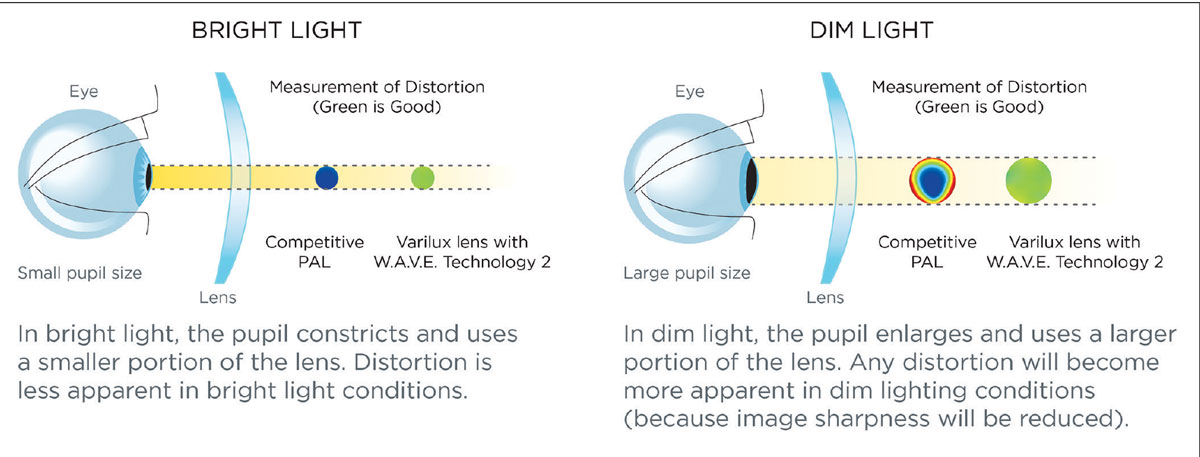 |
Variation in pupil size as lighting conditions change is a common source of PAL dissatisfaction. Essilor says its custom wavefront designs account for this (as well as correcting higher-order aberrations). Click image to enlarge. |
Shamir's Autograph Intelligence and Glacier Expression
For easier adaptation to progressive wear, Shamir created a unique lens design that takes into account the person’s likely near vision needs based on their “visual age.” Called Autograph Intelligence, the lens’s intermediate vision zone has been enhanced by creating a soft transition between intermediate and near, and the power distribution in each lens is modified based on the visual age of the wearer. The company says this approach better reflects real-world visual needs, particularly during computer use.
The company has also identified that the obscuration of a wearer’s eyes by lens glare not only reduces visual clarity but also can change the way we perceive ourselves and the way others perceive us. The use of an antireflective coating can help, however. Shamir says its Glacier Expression AR coating has been designed to increase light transmittance, reduce visual noise and improve contrast sensitivity for the wearer. The company states that their clinical research shows use of Glacier Expression AR coating allows one to gain significantly accelerated reaction times, especially when driving at night, compared with standard AR coatings.
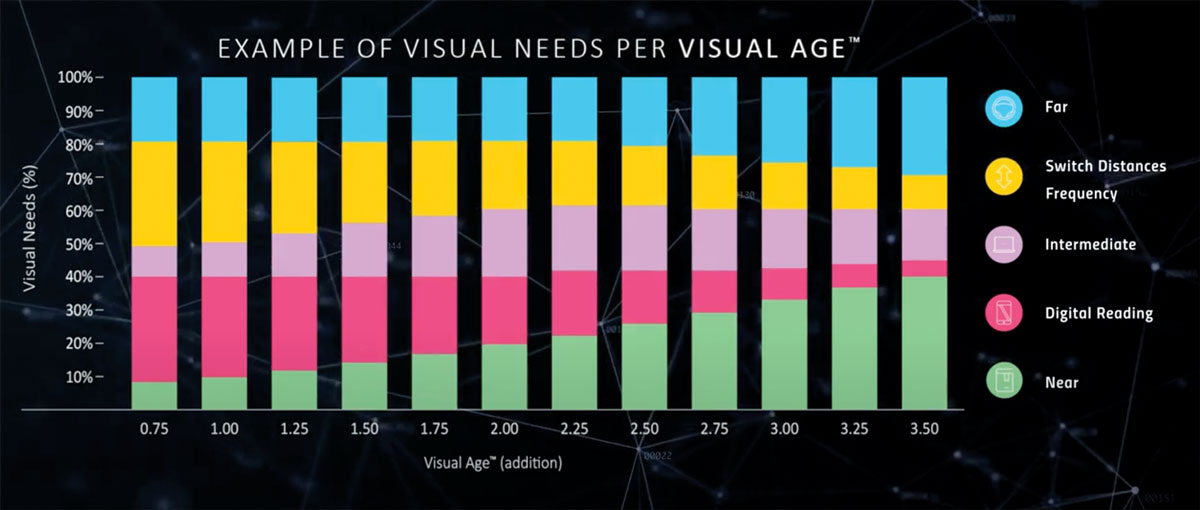 |
Shamir has devised the concept of “visual age” and incorporated it into the power profile of its Autograph Intelligence progressive lenses for better adaptation, the company says. Click image to enlarge. |
IOT’s Endless Office Occupational
Lenses designed expressly for use at work—particularly work involving lots of computer time—have certainly had a moment as of late, considering the fact that many consumers found their habits changed drastically during the COVID-19 pandemic. The Endless Office Occupational lens from IOT is a great choice for occupational lenses, as it offers the ability to tailor the wearer’s experience to their focal range needs. It is available in three focal range options: 1.3m (4.2ft), 2m (6.5ft) and 4m (13.1ft). These selections allow for you to distinguish the needs of a patient who needs only to see their computer screen and near-vision vs. a patient who needs to see across a board room or wants to wear their occupational lenses as they move around their workspace, as well as experiencing a wide near-vision zone.
Endless Office lenses are designed to maximize the near and intermediate zones in order to allow the wearer to maintain a comfortable posture by eliminating the need for them to tilt their head up in order to reach their intermediate zone. IOT’s freeform manufacturing technology (Digital Ray-Path 2) and compensated design reduces the oblique aberrations that are commonly referred to as peripheral blur, giving the wearer a feeling of width in their near and intermediate viewing tasks, and a comfortable computer viewing experience.
Essilor’s Crizal Rock AR Coating
If you’re looking for an extra level of durability in AR coating performance, you might consider the Crizal Rock coating from Essilor. A study found that, on average, 77% of eyeglass wearers wipe their lenses with t-shirts, tissues or towels at least once per week.2 Crizal Rock uses a “high-resistance” oxide that is described as a combination of specific oxides chosen to resist scratches and dust, as well as a “high surface density super hydrophobic layer” that is intended to repeal smudges and improve ease of cleaning. Essilor’s testing shows these lenses to be three times more scratch resistant than entry-level Crizal coatings.
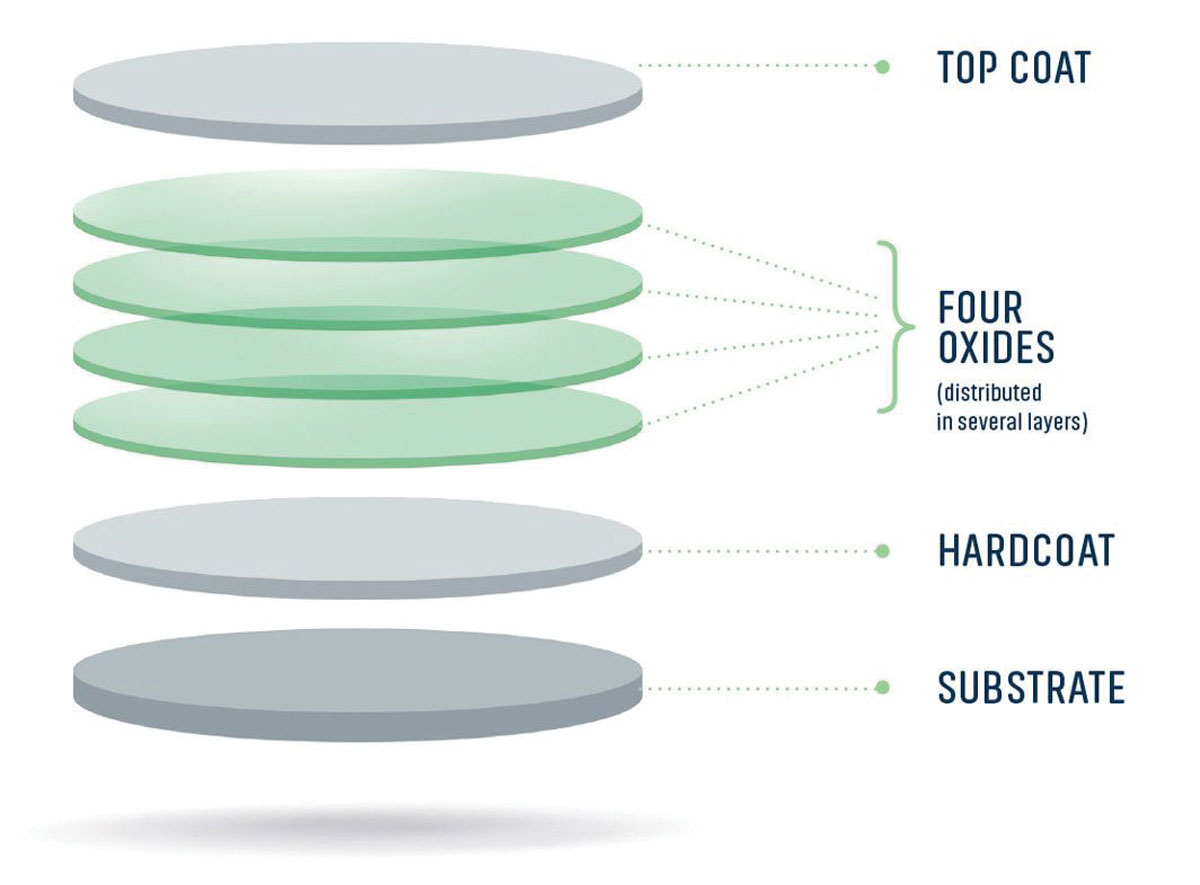 |
Essilor’s Crizal Rock AR coating uses four layers of oxide to resist scratches and dust, as well as a hydrophobic layer intended to repel smudges and improve ease of cleaning. Click image to enlarge. |
Zeiss ClearView
Stock single vision lenses get too little attention these days. This segment of the market could use a bit of an upgrade when you consider that, visually, standard single vision lenses are great when the optical center is taken into account but can underperform at areas outside of the optical center. Zeiss had these goals in mind when designing its ClearView lenses, which are up to 16% thinner than their other spherical lenses and up to 8% thinner than aspherics. By use of freeform technology, Zeiss has created a single-vision lens with three times larger central viewing zone vs. a standard aspherical lens.
The company also has identified that the eye’s center of rotation varies by prescription and has taken this into account with the ClearView. The use of these center of rotation compensations creates wider viewing zones, especially noticeable in the peripheral meridians. Excitingly, Zeiss has been able to formulate its freeform design into stock lenses, allowing for a distinct difference from the stock lenses most practices use today. This lens could radically change the single vision lens space.
Takeaways
As you can see, many companies are taking a different approach when creating the next best lens. The options are endless and it’s a lot to take in, but it’s an exciting time for you and your patients when making the best decision to help them see and feel better.
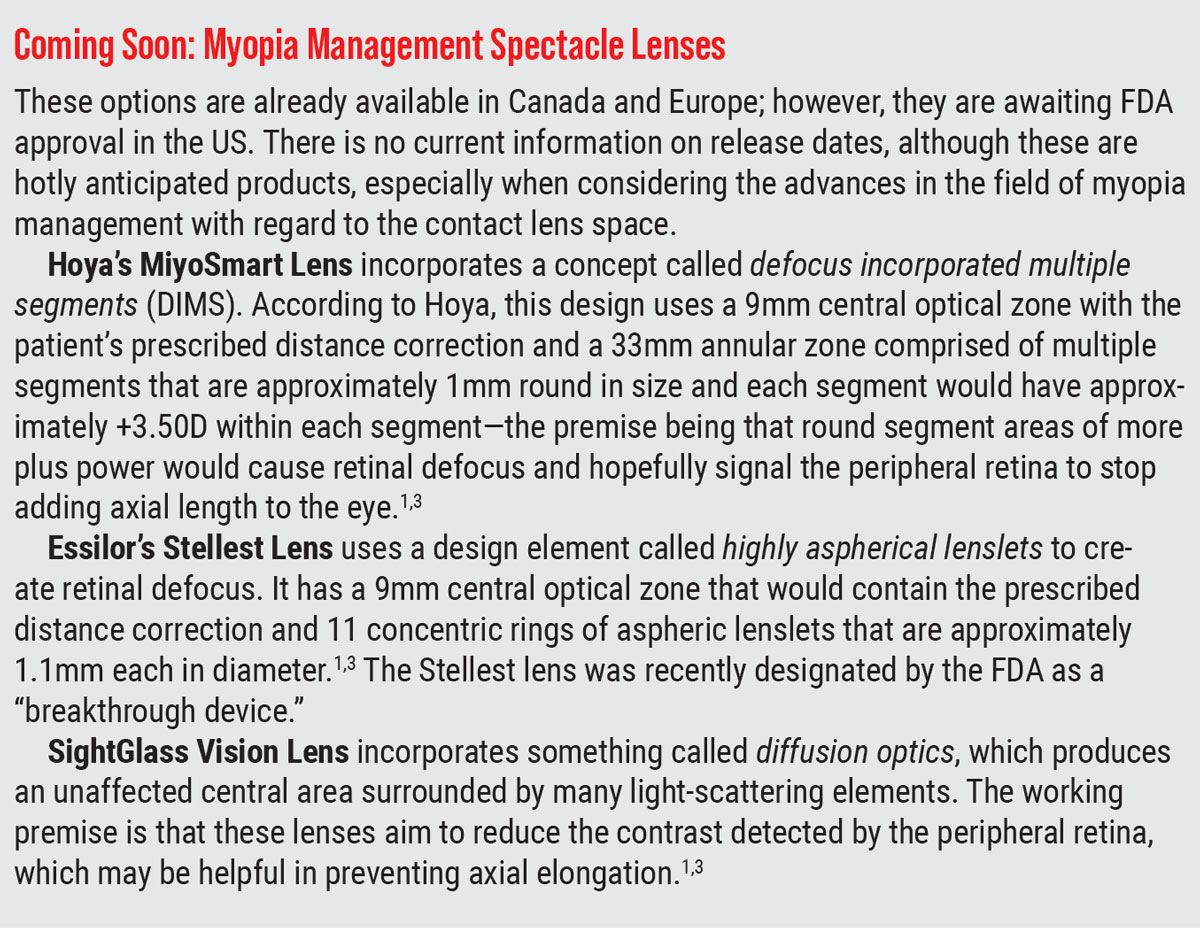 |
Johnna Dukes is a board-certified optician who owns her own optical boutique in Spirit Lake, Iowa. She is past-president of the Opticians Association of Iowa and the current president of the Opticians Association of America. Johnna has over 20 years in the optical industry, as well as both private practice and retail setting experience. She is an American Board of Opticianry-certified speaker and was named one of Vision Monday’s most influential women in optical in 2021.
1. Bullimore M. The latest science on myopia control spectacles. Review of Myopia Management. www.reviewofmm.com/the-latest-science-on-myopia-control-spectacles. November 1, 2021. Accessed February 20, 2023. 2. Crizal Rock sales aid. Essilor. info.icarelabs.com/hubfs/Crizal%20Rock%20One-Page%20Sales%20Aid.pdf. Accessed February 20, 2023. 3. Philip K, PhD. What’s new in spectacle lenses for myopia management? Brien Holden Vision Institute. January 1, 2021. bhvi.org/news/whats-new-in-spectacle-lenses-for-myopia-management. Accessed February 20, 2023. |

